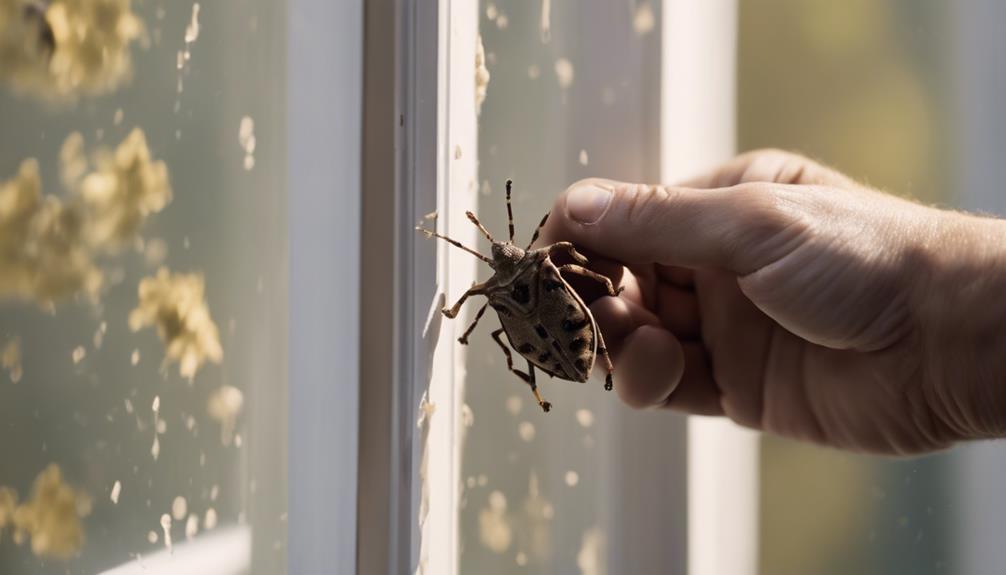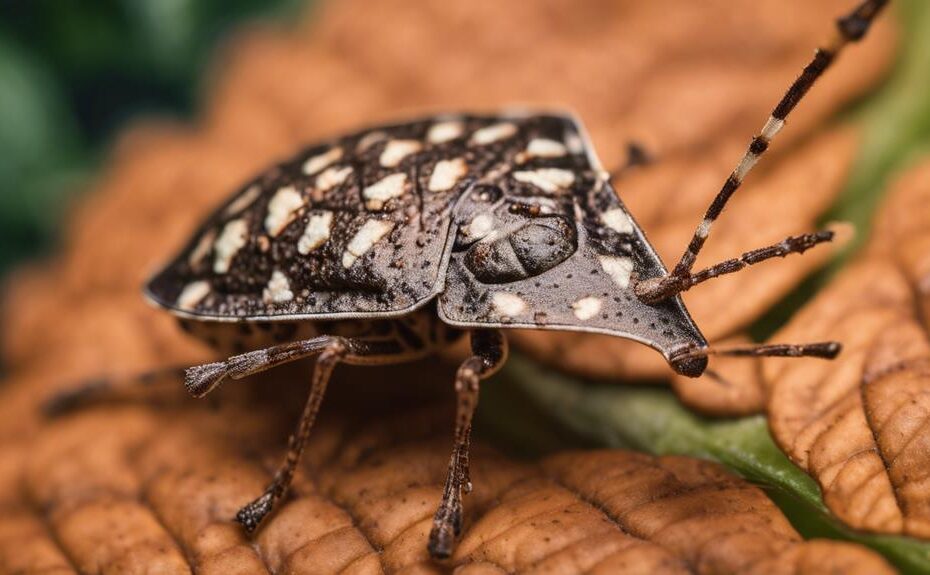You probably don't realize how much of a nuisance the Brown Marmorated Stink Bug can be until it's too late. Its unassuming appearance belies the trouble it can cause. Understanding its physical characteristics, behavior, and ways to control it is crucial.
From infiltrating homes to wreaking havoc on crops, this invasive species demands attention. Let's explore how to identify, prevent, and manage encounters with this pesky bug before it becomes a persistent problem.
Physical Characteristics
When observing the physical characteristics of the Brown Marmorated Stink Bug, one immediately notices its distinctive shield-shaped body and marbled brown coloring. These color variations serve as excellent camouflage, blending seamlessly with tree bark and leaves where they often reside. The marbled pattern on their shield-shaped backs consists of various shades of brown, giving them a unique appearance that helps them remain hidden from predators.
The distinctive markings on the Brown Marmorated Stink Bug play a crucial role in its survival. Alongside their shield-shaped bodies and marbled brown coloring, these bugs have specks of darker brown and white on their antennae and legs. These markings aid in their camouflage, making them appear like natural elements in their environment. Additionally, the subtle variations in color help them evade detection by predators and remain well-hidden in the foliage where they feed and reproduce.
Habitat and Behavior
The Brown Marmorated Stink Bug typically inhabits a variety of outdoor environments, displaying distinct behaviors that contribute to its survival and reproduction. When it comes to nesting habits, these bugs seek shelter in warm and dry places during the colder months, such as inside buildings or under tree bark. They're known to aggregate in large numbers, creating clusters for protection and warmth.
In terms of feeding patterns, the Brown Marmorated Stink Bug has a wide range of host plants, making it a significant agricultural pest. They use their piercing, sucking mouthparts to feed on fruits, vegetables, and ornamental plants. These bugs have a preference for fruits like apples, peaches, and berries, causing damage to crops by sucking out the juices and leaving behind corky scars. Understanding their feeding habits is crucial for implementing effective pest management strategies to protect crops from infestations.
Life Cycle

During their development, Brown Marmorated Stink Bugs undergo a series of distinct stages that collectively form their life cycle.
- Egg Laying: Female Brown Marmorated Stink Bugs lay clusters of eggs on the underside of leaves or stems, typically in the spring. Each egg cluster can contain up to 28 eggs, which are barrel-shaped and light green in color.
- Nymph Emergence: After about a week, the eggs hatch, and nymphs emerge. These immature stink bugs, known as nymphs, undergo five molts over the course of 4-6 weeks. During each molt, the nymph sheds its exoskeleton to accommodate its growth.
- Nymph Development: As the nymphs grow, they transition through five instars, becoming larger and more similar in appearance to adult stink bugs with each molt.
- Adult Stage: Once the nymphs complete their development, they reach adulthood. Adult Brown Marmorated Stink Bugs are approximately 1.5 cm long, have a shield-shaped body, and display the characteristic mottled brown coloration.
Damage Caused
The Brown Marmorated Stink Bug inflicts significant damage on crops, impacting agricultural yields and quality.
By piercing fruit and vegetables to feed on their juices, the bug causes physical blemishes and deformities that render produce unsuitable for sale.
This agricultural pest results in substantial economic losses for farmers and can disrupt local and regional food supplies.
Crop Damage Impacts
Crop damage impacts caused by the Brown Marmorated Stink Bug can be devastating to various agricultural crops, leading to economic losses and reduced yields. When these pests infest crops, they cause significant harm through:
- Feeding: The stink bugs pierce the plant tissues with their needle-like mouthparts, causing distortion and discoloration of fruits and vegetables.
- Fruit Damage: Fruits develop corky patches, depressions, and necrotic areas, making them unmarketable.
- Seed Destruction: Stink bugs target seeds, leading to reduced germination rates and poor crop establishment.
- Secondary Infections: Wounds created by feeding provide entry points for pathogens, exacerbating crop damage and reducing quality.
Effective pest management strategies, such as integrated control methods, are crucial to minimize these detrimental impacts.
Economic Losses Incurred
Pivoting from the discussion on Crop Damage Impacts, the economic losses incurred due to the Brown Marmorated Stink Bug's destructive behavior on agricultural crops are significant and far-reaching. The economic impact of these pests stems from the reduction in crop yields, increased production costs due to control measures, and potential trade restrictions on infested produce.
Agricultural losses occur as the stink bugs pierce the fruits and vegetables to feed, causing physical damage and creating entry points for pathogens that further deteriorate the quality of the crops. Additionally, the need for extensive insecticide applications to manage infestations adds to the financial burden on farmers.
These cumulative effects highlight the substantial economic consequences associated with the presence of Brown Marmorated Stink Bugs in agricultural settings.
Natural Predators

In the battle against the Brown Marmorated Stink Bug, natural predators play a crucial role in controlling their population. Predatory insects are essential for biological control strategies aimed at managing stink bug populations.
- Ladybugs: These colorful beetles are voracious predators of stink bug eggs and early instar nymphs. Their appetite for these young stink bugs helps reduce the overall population.
- Praying Mantises: Known for their stealthy hunting techniques, praying mantises are skilled predators that feed on adult stink bugs. Their presence in gardens can help keep stink bug numbers in check.
- Birds: Some bird species, such as sparrows and starlings, include stink bugs in their diet. By preying on stink bugs, birds contribute to natural stink bug control.
- Spiders: Certain spider species are effective predators of stink bugs. They catch stink bugs in their webs or actively hunt them, aiding in the suppression of stink bug populations.
Prevention Tips
Natural predators are an integral part of managing Brown Marmorated Stink Bug populations; now let's focus on effective prevention tips. To prevent infestations of these pesky bugs, implementing integrated pest management strategies is crucial. Here are some key prevention tips to keep Brown Marmorated Stink Bugs at bay:
| Prevention Method | Description |
|---|---|
| Seal Entry Points | Inspect and seal cracks, crevices, and gaps in doors, windows, and walls to prevent entry. |
| Remove Host Plants | Eliminate plants like ornamental fruit trees that attract stink bugs from your immediate area. |
| Proper Storage Practices | Store firewood, boxes, and outdoor equipment off the ground and away from the house perimeter. |
Control and Removal

To effectively control and remove Brown Marmorated Stink Bugs from your property, it's essential to implement targeted pest management strategies. These invasive pests can be challenging to eliminate, but with the right approach, you can significantly reduce their numbers and prevent infestations. Here are some key steps you can take:
- Chemical Treatments: Consider using insecticides labeled for stink bug control. Apply these chemicals according to the instructions to effectively target and eliminate the bugs.
- Integrated Pest Management: Adopt a holistic approach that combines different control methods such as trapping, habitat modification, and biological controls. This strategy can help disrupt the stink bugs' life cycle and reduce their populations.
- Regular Monitoring: Keep a close eye on areas where stink bugs are commonly found. Early detection is crucial for effective control.
- Sealing Entry Points: Seal cracks, gaps, and openings in your home to prevent stink bugs from entering. This simple step can help reduce the chances of an infestation.
Frequently Asked Questions
Can Brown Marmorated Stink Bugs Harm Pets or Humans With Their Odor?
Yes, brown marmorated stink bugs can harm pets and humans with their strong odor. This odor impact can cause irritation and allergic reactions in some individuals.
While the smell itself isn't harmful, prolonged exposure can lead to health risks. Effective pest management strategies, such as biological control through natural enemies like parasitoid wasps, can help control stink bug populations and reduce their impact on both pets and humans.
Are There Any Known Benefits to Having Brown Marmorated Stink Bugs in the Environment?
In the intricate dance of nature, brown marmorated stink bugs do offer some environmental benefits.
These bugs, while considered agricultural pests due to their appetite for crops, can also serve as prey for certain predators, helping to maintain a balanced ecosystem.
Despite their nuisance, their presence can contribute to the intricate web of life within the environment, showcasing the interconnectedness of all living beings.
How Do Brown Marmorated Stink Bugs Communicate With Each Other?
To communicate, brown marmorated stink bugs use chemical signals like pheromone trails. These signals help them locate and attract mates, establish territories, and coordinate group behaviors.
Can Brown Marmorated Stink Bugs Be Used for Any Type of Pest Control?
You may wonder if brown marmorated stink bugs can aid in pest control.
While these bugs have natural predators that sometimes help control their population, they aren't typically used as a method of pest management due to their own agricultural impact.
These insects can cause damage to various crops, making them more of a nuisance than a solution for pest control.
Are There Any Cultural or Historical Beliefs or Superstitions Surrounding Brown Marmorated Stink Bugs?
Sure!
Folklore traditions and cultural beliefs surrounding brown marmorated stink bugs are scarce. However, historical superstitions and mythological connections might exist in some regions.
These insects aren't typically tied to significant cultural or historical beliefs, but local stories or superstitions could potentially attribute unusual powers or meanings to them.
It's always fascinating to explore how different cultures interpret and incorporate various creatures into their folklore and beliefs.
Conclusion
In conclusion, the brown marmorated stink bug may seem like a mere nuisance, but its presence serves as a reminder of the delicate balance of nature.
Just as this bug can infiltrate our homes and gardens, so too can negativity and challenges enter our lives.
By taking proactive measures to prevent and control these pests, we can also protect ourselves from the unseen threats that seek to disrupt our peace and harmony.
Stay vigilant and resilient in the face of adversity.

